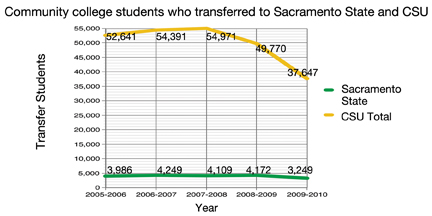Bill to streamline transfer process

Megan Harris::Megan Harris – State Hornet
September 15, 2010
Transferring from a California community college to a California State University campus may become easier if a bill, now on Gov. Arnold Schwarzenegger’s desk, is signed into law.
Senate Bill 1440, known as the Student Transfer Achievement Reform Act, aims to streamline the transfer process by creating transfer associate degrees at the community college level. Students who earn the 60-unit degree would be guaranteed admission to a CSU campus with junior status.
“It’s just one of those things we can all rally around,” said Chris Chavez, president of the California State Student Association, the organization made up of the student governments of all 23 CSU campuses. “It’s going to save students and our colleges a lot of money &- students don’t need to pay for similar courses, allowing other students who need those classes to enroll.”
The bill has a good chance of becoming law, Chavez said.
“(But) we don’t want to count our chickens too early,” he said.
Many California community colleges already have transfer agreements with individual CSU campuses, but SB 1440 would create a standard curriculum that could be applied to most CSU campuses, said Sacramento State Associate Vice President for Enrollment Management Ed Mills.
“The transfer associates degree has a larger chance of gaining acceptance at the CSU campuses, making it easier for students to transfer,” Mills said.
The CSU chancellor’s office and the California Community Colleges chancellor’s office estimate that streamlining the transfer process could save the state about $160 million per year. This would allow the community college system to serve 40,000 more students per year, and the CSU system 13,000 more students per year, according to the release.
The bill would also prevent community colleges from requiring additional courses for the degree, according to the release.
Some people at the community college level were critical of the early versions of the bill, said Alex Pader, president of the Student Senate for California Community Colleges.
“If the bill was not correctly implemented, the community colleges’ apportionments could have been taken away,” Pader said. “But the language was all worked out and now everyone is on board.”
Pader also believed SB 1440 has a good chance of becoming law.
“It’s something that saves the state money. It’s good forstudents because there will be more degrees out there. There are not many things to dislike about this bill,” Pader said.
Though transfer enrollment was restricted earlier this year due to budget cuts, future transfer students will benefit from the bill, Mills said.
Sac State typically takes 4,000 transfer students in the fall and 2,000 in the spring. Last spring, Sac State closed transfer enrollment. This semester, the university cut overall enrollment by 2,000 students, Mills said.
“Right now transfer enrollment is more affected by budget restrictions than anything else,” Mills said. “But that won’t last forever. SB 1440 will make it easier for future students to transfer. It will provide avenues for community colleges to really streamline the process.”
Sac State is accepting transfer applications next semester. But until the state budget is passed, it is unclear whether any transfer students will be enrolled, Mills said.
Padilla’s office did not respond to The State Hornet’s requests for comment on the bill. But in a press release, Padilla said the average transfer student completes 20 more units of coursework than what is required.
Only 25 percent of community college students who intend to transfer to a four-year university actually do, partially due to repetition of courses and changing transfer requirements, the release said.
“Students shouldn’t see coursework and transfer as moving targets, the requirements should be clear and the rewards should be certain. SB 1440 provides that clarity and certainty,” Padilla said in the release.
Ken Paglia can be reached at [email protected].






































































































































